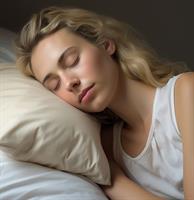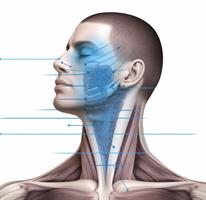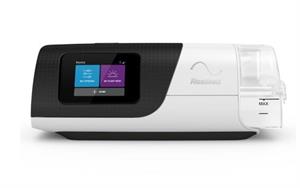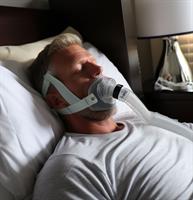Imagine finally getting a good night’s sleep, free from the constant disruptions caused by sleep apnea.
What if the key to achieving that rested feeling lies in the way you sleep? Understanding the relationship between the best sleep position for sleep apnea and this common sleep disorder can be a game-changer for those seeking relief.
Key Takeaways
-
Side sleeping is the optimal position for sleep apnea sufferers, while back sleeping should be avoided.
-
Pillows and positional therapy devices can help to maintain an appropriate sleep position.
-
Healthy lifestyle modifications and CPAP therapy are additional management techniques used to improve overall sleep quality.
The Impact of Sleep Positions on Sleep Apnea
The position in which you sleep can significantly impact the severity of your sleep apnea symptoms. For some, a simple change in sleeping position can make all the difference in reducing the frequency of apnea episodes and improving overall sleep quality.
However, not all sleeping positions are created equal when it comes to sleep apnea management.
The following discussion will focus on identifying beneficial and harmful sleep positions for individuals with sleep apnea. Additionally, we will provide tips on maintaining an ideal sleep position for improved sleep quality.
Side Sleeping: The Optimal Position
Side sleeping is considered the best position for those with sleep apnea. This position counteracts the gravitational force that may cause the tongue and tissues to block the airway, making it one of the best positions for sleep apnea. In particular, sleeping on the right side can reduce snoring and facilitate better blood flow, contributing to a good night’s sleep.
For the most benefits from side sleeping, remain extended rather than curling up, to prevent complications like acid reflux. For those using a CPAP machine, side sleeping may enable a reduction in air pressure, as this position facilitates easier breathing.
Therefore, trying side sleeping might be beneficial if you’re grappling with sleep apnea.
Stomach Sleeping: A Controversial Option
The topic of stomach sleeping for sleep apnea sufferers is a debated one. Some studies have demonstrated benefits, such as a 2019 study revealing that sleeping in a prone position could benefit individuals with mild sleep apnea. However, stomach sleeping can also cause neck strain and may impede the use of continuous positive airway pressure (CPAP) devices, which are frequently utilized for sleep apnea treatment.
If you choose to sleep on your stomach, turn your head to the side to allow room for breathing, and use a thin pillow under the pelvis and abdomen to prevent hyperextending the neck. As always, consult with a healthcare professional to determine the best sleep position for your individual circumstances.
Back Sleeping: The Worst Position
Back sleeping is the least recommended position for sleep apnea patients. Gravity exerts a downward pull on the tongue and throat tissues, resulting in airway obstruction. This position can exacerbate symptoms, especially for those with moderate sleep apnea.
To reduce the adverse impacts of back sleeping, you can:
-
Utilize a firm mattress
-
Abstain from using pillows
-
Elevate the head with a wedge pillow
-
Turn the head slightly to the side
-
Use a small pillow to maintain the turned head position
These measures can assist in reducing the negative effects of sleeping on your back.
Strategies for Maintaining the Right Sleep Position
A consistent sleep position is key for those with sleep apnea who aim to improve their sleep quality and lessen symptoms. The subsequent discussion will cover numerous strategies to maintain an ideal sleep position. These include using supportive pillows, positional therapy devices, and creating a comfortable and well-aligned sleep environment.
Using supportive pillows can help keep your head and neck in the correct position while you sleep, ensuring a good night’s sleep.
Pillows for Support
Supportive pillows are instrumental in providing comfort and preserving the ideal sleep position for those with sleep apnea.
For side sleepers, a thicker pillow is advised to keep the neck aligned with the chest and lower back. Body pillows for side sleeping and wedge pillows for elevating the head are other options that can aid in preserving the natural curvature of the spine and promote proper alignment.
Moreover, there are a variety of pillows specifically designed for sleep apnea patients, such as:
These pillows are engineered to provide additional support and comfort while accommodating CPAP machines and masks.
Positional Therapy Devices
Devices for positional therapy, like tennis balls in a sock or specific sleep shirts, aid in preventing unanticipated rolling onto the back while asleep. These devices are designed to promote and sustain a particular sleep position, usually on the side, in order to help alleviate sleep apnea symptoms.
The advantages of using positional therapy devices include a potential reduction in the number of apnea events during sleep and enhanced sleep quality. By incorporating these devices into your sleep routine, you can increase the likelihood of maintaining the optimal sleep position and improve your overall sleep experience.
Adjusting Sleep Environment
A sleep environment that is both comfortable and supportive is vital for preserving correct sleep positioning, leading to enhanced sleep quality. To achieve this, consider:
-
Using an appropriate mattress and pillow
-
Ensuring the room is dark and quiet
-
Selecting a mattress with the optimal level of firmness and adequate posture support
These measures could be advantageous for sleep apnea sufferers, especially for a sleep apnea patient dealing with a sleep disorder after receiving a sleep apnea diagnosis.
Moreover, maintaining a clean and fragrant bed can improve indoor air quality, allowing for better respiration. By adjusting your sleep environment, you can create a comfortable space that promotes proper sleep positioning and helps manage sleep apnea symptoms.
The Importance of Proper Head and Neck Alignment
Proper head and neck alignment is crucial for sleep apnea sufferers, including those with central sleep apnea and obstructive sleep apnea, as it assists in optimizing airflow and decreasing upper-airway obstruction during sleep.
We will discuss specific suggestions to achieve correct alignment of the head and neck in each sleep position, which could help to prevent snoring and enhance the effectiveness of sleep apnea treatment.
Aligning the Head and Neck in Side Sleeping
While side sleeping, aligning the head and neck with the spine is necessary to avoid strain and keep the airway open. To ensure proper alignment, use a pillow that keeps the neck aligned with the chest and lower back. Additionally, placing a small pillow underneath the neck and one under the knees can aid in preserving the natural curvature of the spine.
By maintaining proper head and neck alignment in side sleeping, you can effectively reduce the risk of airway obstruction and improve your sleep quality.
Aligning the Head and Neck in Stomach Sleeping
For stomach sleepers, it’s important to minimize airway obstruction by facing downward and using a soft pillow to support the neck. As stomach sleeping can be a controversial option for sleep apnea sufferers, proper head and neck alignment becomes even more crucial in this position.
When sleeping in the stomach position, place a thin pillow beneath the head to ensure alignment of the head and neck. Additionally, a thicker, more supportive pillow should be placed beneath the hips to preserve the proper alignment.
Aligning the Head and Neck in Back Sleeping
In back sleeping, elevating the head and turning it to the side can help reduce breathing disruptions and improve airflow. To achieve this, select a pillow that maintains the neck in alignment with the chest and lower back, and use a wedge pillow to elevate the head.
By maintaining proper head and neck alignment in back sleeping, you can minimize the negative effects of this position and better manage your sleep apnea symptoms.
Additional Sleep Apnea Management Techniques
In addition to sleep positions and proper head and neck alignment, there are other methods to treat sleep apnea that can further improve sleep quality and reduce symptoms.
We will discuss lifestyle modifications and medical treatments, such as CPAP therapy, which can be used together with positional strategies for a holistic approach to managing sleep apnea.
Lifestyle Changes
Lifestyle changes that can help reduce sleep apnea episodes and improve overall sleep quality include:
-
Maintaining a healthy weight
-
Avoiding alcohol and smoking
-
Increasing physical activity
-
Cessation of alcohol and tobacco consumption
These lifestyle modifications may be beneficial for those living with sleep apnea.
By incorporating these lifestyle changes into your daily routine, you can further manage your sleep apnea symptoms and enjoy a more restful night’s sleep.
CPAP Therapy
CPAP therapy is an effective medical treatment for moderate to severe sleep apnea, delivering pressurized air to keep the airway open and prevent apnea episodes. This therapy involves the use of a CPAP machine, which provides pressurized air through a face mask to maintain an open airway during sleep.
Adherence to CPAP therapy is crucial for its effectiveness, and finding the right mask and machine settings can greatly enhance the comfort and success of this treatment. By incorporating CPAP therapy into your sleep apnea management plan, you can further improve your sleep quality and reduce the frequency of apnea episodes.
Choosing the Right Bedding for Sleep Apnea Sufferers
Selecting appropriate bedding, encompassing a comfortable mattress and supportive pillow, is vital for those with sleep apnea to preserve the correct sleep position and enhance sleep quality. A mattress that is supportive and encourages easy respiration should be compatible with sleep apnea treatments such as CPAP machines.
Moreover, clean and fragrant sheets can induce relaxation and improve indoor air quality, allowing for better respiration. By selecting the appropriate bedding and maintaining a clean sleep environment, you can further optimize your sleep position and manage sleep apnea symptoms effectively.
Summary
In conclusion, understanding the impact of sleep positions and the importance of proper head and neck alignment is crucial for sleep apnea management. By combining positional strategies, lifestyle changes, and medical treatments like CPAP therapy, you can take control of your sleep apnea symptoms and enjoy a more restful, rejuvenating night’s sleep. So, make the necessary adjustments, and start your journey towards a better night’s rest today.
Frequently Asked Questions
What position should I sleep in with sleep apnea?
For those with sleep apnea, the best sleeping position is on your side. Research from both OSA and CSA has shown that side sleeping can reduce breathing disruptions significantly.
Does sleeping with head elevated help sleep apnea?
Sleeping with your head elevated can help reduce the severity of sleep apnea by reducing the effects of gravity on the airways. This technique is especially beneficial for people with obstructive sleep apnea (OSA).
What position makes sleep apnea worse?
Sleeping on your back (supine position) is the position that makes sleep apnea worse, as gravity causes the tongue to fall back and block the airway, resulting in more frequent and longer apneas.
How do you fix sleep apnea naturally?
Try making lifestyle changes, such as weight loss, reducing nasal congestion, changing your sleep position, avoiding sedatives, exercising, using a humidifier and oral appliances, to naturally fix sleep apnea.
What lifestyle changes can help manage sleep apnea symptoms?
Making changes to your lifestyle, including weight loss, physical activity, and avoiding alcohol and smoking can all help manage sleep apnea symptoms.








